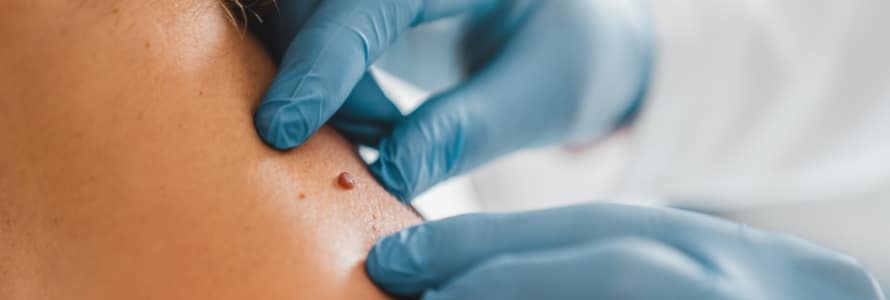
Screening, Diagnosis, Treatment and Management

Melanoma, also called malignant melanoma, is a dangerous form of skin cancer that often resembles moles and can develop from moles. Although the majority of melanomas are black or brown, they can also be skin-colored, pink, red, purple, blue, or white. If melanoma is recognized and treated early, it’s almost always curable. But if it’s not, the cancer can advance and spread to other parts of the body, where it becomes hard to treat.
Skin Cancer Symptoms – The ABCDE’s
Melanoma symptoms are important to catch right away. For men, the most common site of melanoma is on the back, with legs second. For woman, the most common place is on the legs, with back being second. Below are melanoma symptoms that you should look out for.

Asymmetry
One half of the mole that is not equal to the other half in terms of shape, outline, and color.

Borders
The borders are uneven, and may be notched or scalloped.

Color
A variety of colors, including more than one shade of brown, tan, back, and even red, pink or gray may be a troublesome sign.

Diameter
Melanomas are usually larger in diameter than an eraser on a pencil, but they may be smaller when first detected.

Evolving
Any change in size, shape, color, elevation, or other trait, or any new symptoms such as bleeding, itching, or crusting, may be a sign of danger.
Melanoma Diagnosis and Treatment
Dr. Brian Mekelburg will carefully examine the mole and other suspicious spots, and may even use a device called a dermascope to magnify the skin which can help reveal pigments and structures that are not seen with ordinary magnification.
If Dr. Brian Mekelburg finds a suspicious mole or spot, he will remove it (or part of it), and send the specimen to the lab. This procedure is called a biopsy. Melanoma cannot be diagnosed without a biopsy.
The biopsy is quick and safe and the discomforts and risks are minimal and should not cause anxiety. A positive biopsy report may also tell us the level of the melanoma. The level can tell us how deeply the cancer has grown into the skin. The deeper it has grown, the more dangerous the melanoma.

Surgical excision of the remaining melanoma and a margin of uninvolved surrounding skin is the mainstay of treatment. Many times, for the more superficial tumors, this is easily accomplished in Dr. Brian Mekelburg’s office as a minor outpatient procedure. For deeper, more advanced melanomas, it may be necessary to examine the lymph nodes in the region. A “sentinel node” biopsy is usually performed under general anesthesia as an out-patient, sometimes, as an in-patient. Diagnostic tests, such as CT scans may be needed. Treatment of more advance melanomas may involve more complex treatments such as chemotherapy and immunotherapy under the care of an oncologist.
The vast majority of melanomas are diagnosed in the earliest, most superficial stage. These are almost 100% curable. It’s very important to have a yearly skin exam so that a melanoma can be caught in its earliest stage. If there are higher risk factors, an exam twice a year may be advisable.
Risk Factors of Melanoma
Sun Exposure
Melanoma is mainly caused by intense, occasional exposure to ultraviolet (UV) light (frequently leading to sunburn). The more UV exposure, the higher the risk. Blistering sunburns in childhood increase the risk, but cumulative exposure may also be a factor.
Number of moles on the skin
The greater the number, the higher the risk.
Skin Type
The more fair-skinned and easily sunburned, the higher the risk.
Genetics
While UV exposure is a frequent culprit, genetic predisposition to melanoma is a significant factor. Individuals who have a first-degree relative (immediate family member, a parent or siblings), with a history of melanoma, have a 50% higher risk to develop one. For a more in-depth discussion, visit www.skincancer.org/skin-cancer-information/melanoma.
For a more in-depth discussion of melanoma, please see:
Dermatologist of Los Angeles, Brian P. Mekelburg, MD, FAAD stands ready to perform a comprehensive skin exam for all of his patients. Even if you’re coming to us for an unrelated problem, we offer this exam as part of our service. Contact us today to set up an appointment.


